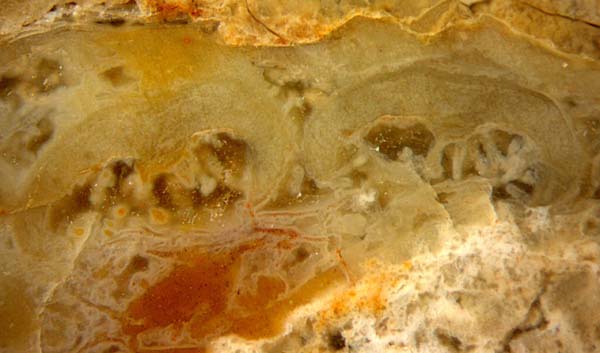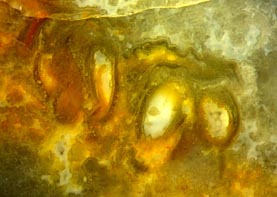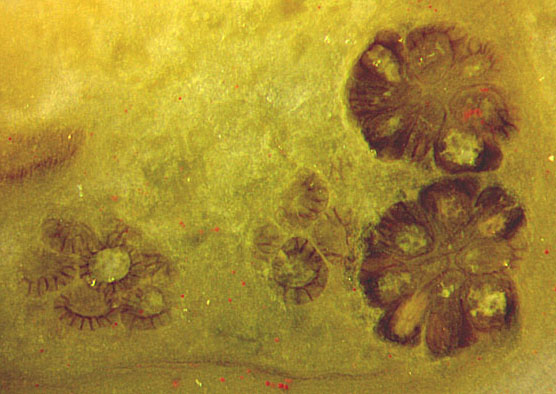Various peculiar sporangia in one
chert sample
What is peculiar about the sporangia shown
here becomes obvious by considering that this chert sample is one of
many hundreds recovered from the type locality of
the fossil tree fern Scolecopteris
elegans [1], whose stem is known as Psaronius. Chert
with fern pinnules
superficially resembling little creatures had been called "maggot
stone" [2]. The large majority of the
plant fragments seen in the maggot stones belong to the tree fern Scolecopteris
elegans so that it had been assumed [3] that there were
no other ferns growing in the swamps turned
into chert. Hence, any detail
indicating the presence of other ferns in
the Lower Permian cherts from Döhlen basin deserves
attention [4,5]. 
Incidentally, there are more than one piece of evidence for the
presence of other ferns in this chert sample: fat pinnules
with numerous hairs below (Fig.1), others with big sporangia
(Fig.2), sporangia with two conspicuous hairs near
the tip (Fig.3), and, as another quite uncommon sight in these
cherts, small sporangia apparently not compatible
with Scolecopteris
(Fig.4).
Incidentally again, there are a few mm-size objects
in this sample resembling extant fern seedlings, which will be the
subject of another contribution.
Fig.1: Two cross-sections of sterile fern pinnules of big size,
with hairs on the midrib, image width 7mm.
This
image may be confusing at first sight because the contours of the
pinnules are hardly visible. The pinnules
are distinctly bigger than those of Scolecopteris
elegans,
hence most probably they represent another species. Part of the
confusing aspect is due to the hairs emerging from the
midrib (and from the lateral veins, not seen here). Although hairs on
the lower side of the pinnules are not rare, they are seldom
seen on photographs or drawings of sections. They are mentioned in [6]
and seen in Fig.4a there on the small pinnules of Sc. elegans. (The
scale is erroneous there, not 5:1 but 10:1.) They are
also seen in [7].



Fig.4: Uncommonly small sporangia,
same scale as Figs.1-3, enlarged in Fig.5.
Fig.3 (above): Sporangia with hairs near the tip, cut off on the left
sporangium.
Fig.2: Inclined section of fertile fern pinnule of
big size, image width 3.2mm.
The pinnules and the sporangia in Figs.1-3 (same
scale) are distinctly
larger than those
of Sc. elegans.
As a queer coincidence, this chert sample offers much smaller
sporangia,
too, as seen in Fig.4, same scale. They differ from those of Sc. elegans not
only by their size
but also by their aspect, which becomes obvious by comparing
Fig.5 with the figures in [5]. Remarkable are the clustering
of 7 or 8 sporangia and their walls
consisting of cells arranged in one layer.
The latter feature is typical for leptosporangiate ferns, which include
most extant ferns and are widely separated, in a phylogenetic sense,
from
the eusporangiate ferns including Scolecopteris.
Fig.5 suggests
an interpretation as Oligocarpia,
which, according to
Zeiller in [8], has got 3 to 10 pyriform sporangia in
circular clusters (sori). Oligocarpia lindsaeoides [9]
from Bohemia has got similar sporangia as in Fig.5 but only 4 or 5 per
sorus. Oligocarpia leptophylla,
known from the Döhlen basin as compressions [10], has got sporangia
of similar size, poorly preserved, and
arranged in larger clusters with up to 20 per sorus. Apparently
the present fossil fragment, well preserved in chert, with 7 and 8
sporangia per sorus seen on the cut face, represents a species that may
be placed in between.

Fig.5: Uncommonly small sporangia in chert
(three times magnified with respect to Figs.1-4), resembling those of Oligocarpia.
Width of the picture 2mm.
Conclusions derived from this chert sample found
at the classical location of the "maggot stones":
- It provides additional evidence of the existence
of more than one
Scolecopteris
species there.
- It reveals a leptosporangiate fern, probably Oligocarpia,
having lived in the same habitat as the eusporangiate Scolecopteris.
Thanks are due to the fossil collector Gert
Müller
(Dresden + Düren), who found this chert boulder, from whose
cut faces all
pictures have been taken, at the "maggot stone" site (at the
boundary between the
municipalities Kleinnaundorf and Burgk, Freital) in 2003. It is now
stored in
the own collection under the
label
Bu7/140.
H.-J.
Weiss
2018
[1] F.C. Zenker :
Scolecopteris elegans, ein neues fossiles Farrngewächs mit
Fructification. Linnaea 11(1837), 509-12
[2] M. Barthel,
R. Rößler, H.-J.
Weiss: Sächsische "Madensteine" - Irrtümer und
Fortschritte. Geologica
Saxonica 46/47(2001), 197-202.
[3] M. Barthel:
The maggot stones from Windberg ridge. in: U. Dernbach, W.D. Tidwell:
Secrets of Petrified Plants. D'ORO
2002, 65-77.
[4]
H.-J. Weiss: Beobachtungen
zur Variabilität der Synangien des Madenfarns. Veröff. Mus. f.
Naturkunde Chemnitz 25(2002), 57-62.
[5]
www.chertnews.de, Permian Chert News 5: Conspicuous in the
chert -
synangia of Scolecopteris.
[6] M. Barthel: Gibt
es einen Farn Scolecopteris
arborescens ? Veröff. Naturk. Erfurt 24(2005), 5-11.
[7]
www.chertnews.de,
Permian Chert News 17: Microbes, fungi, maggot fern.
[8] A.C.
Seward: Fossil Plants II, Cambridge Univ. Press 1910,
Fig.270B.
[9] J.
Psenicka, J. Bek: Oligocarpia
lindsaeoides [9]
... from ... Central Bohemia, Acta Mus. Nationalis Pragae, B,
Historia Naturalis 57(2001), 57-68.
[10] M. Barthel:
Die Rotliegend-Flora der Döhlen-Formation. Geologica
Saxonica 61(2), 2015, 108-229.
|
 |
 20 20 |

 20
20





 20
20